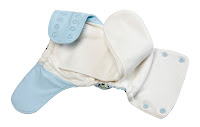Three Purposes of Diaper Liners
As you know, most diaper creams (over-the-counter and prescription) are not safe for cloth diapers, as they can permanently adhere to the diaper fabric and cause wetness to repel from the diaper. These creams do not wash out of the diapers. Unless you use coconut oil or cloth-diaper-safe-creams, you will need to use a liner in your cloth diaper every time you put cream on your baby's bum.
Secondly, a diaper liner can be used as a stay-dry layer between baby's bum and an absorbent fabric that may be harmful or too wet on baby's bum. For example, some natural fibers can irritate the skin and cause a rash. Also, while microfiber is a great, quick absorber, microfiber should never be place directly against baby's bum, as it will draw out moisture from the skin. If using the liner for to protect the skin, be sure the liner fully covers the irritating fabric.
Some moms chose to use liners with every diaper change as a way of limiting the amount of contact sticky poo has with the diaper. If using liners in order to cut down on clean-up, it makes sense to use a flushable liner (vs. reusable liner). Let's discuss the pros and cons of each type.
Flushable vs. Reusable Diaper Liners
Flushable liners are nice for convenience sake, but they aren't perfect. Many moms find they are too thin and move around in the diaper too much to be effective or comfortable for baby. Some complain the wipes are scented and, therefore, contain unnecessary chemicals.
 Reusable liners do take a little more effort. I find the biggest inconvenience to be the requirement that I wash the liners separately from my diapers when using cream or Vaseline. That being said, reusable liners are inexpensive to buy or make yourself. I have multiplied my supply, so I can have enough liners to last me through a week of use. Then, I just throw the liners in with baby's regular laundry (after a quick pre-rinse following each diaper change).
Reusable liners do take a little more effort. I find the biggest inconvenience to be the requirement that I wash the liners separately from my diapers when using cream or Vaseline. That being said, reusable liners are inexpensive to buy or make yourself. I have multiplied my supply, so I can have enough liners to last me through a week of use. Then, I just throw the liners in with baby's regular laundry (after a quick pre-rinse following each diaper change).Buying vs. Making Reusable Liners
A few reusable diaper liners are commercially marketed these days: Bummis (pictured above) and Kanga Care are the biggest sellers, and go for around a dollar each. Many sellers on Etsy.com market liners made of fleece, microfleece, cotton velour, suedecloth. These same fabrics are carried at most local and chain fabric stores, and are very affordable; for this reason, I opted to make my own. I believe I spent around five bucks at Hancock Fabrics for some super-soft buttersuede (their version of suedecloth), and I have made at least 15 liners, with plenty of fabric left-over. If you can't find the fabric you want in your area, you can buy several appropriate fabrics on Amazon. The great thing about "making" liners from suedecloth, and some fleece fabrics...all you have to do is measure and cut the fabric. These materials do not fray with use. Super easy! I have used both fleece and microsuede liners.
In terms of deciding which fabric to use, I have found that poo slides off of suedecloth much easier than off of fleece. The suedecloth also dries much quicker than fleece. I did find that the fleece seemed to stay in place better than suedecloth, because the suedecloth I used has a somewhat slippery backside. All in all, I continue to like the suedecloth liners I made the best, and I continue to use them when needed.
What type of liners do you use?













